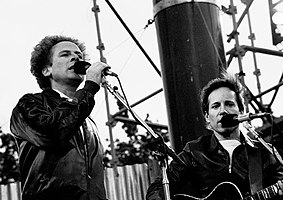Simon & Garfunkle
| Simon and Garfunkel | |
|---|---|

Art Garfunkel (L) and Paul Simon (R)
performing in Dublin, 1982 |
|
| Background information | |
| Origin | Forest Hills, Queens, New York City, U.S. |
| Genres | Folk rock |
| Years active | 1956–1970 Reunions: 1972, 1975-1977, 1981–1984, 1990, 1993, 2003–2005, 2007–2010 |
| Labels | Columbia |
| Website | simonandgarfunkel |
| Past members | |
Simon & Garfunkel was an American folk rock duo consisting of singer-songwriter Paul Simon and singer Art Garfunkel. They were one of the best-selling music groups of the 1960s and became counterculture icons of the decade's social revolution, alongside artists such as the Beatles, the Beach Boys, and Bob Dylan. Their biggest hits—including "The Sound of Silence" (1964), "Mrs. Robinson" (1968), "The Boxer" (1969), and "Bridge over Troubled Water" (1970)—reached number one on singles charts worldwide.
Their often rocky relationship led to artistic disagreements, which resulted in their breakup in 1970. Their final studio record, Bridge over Troubled Water (released in January of that year), was their most successful, becoming one of the world's best-selling albums. Since their split in 1970 they have reunited several times, most famously in 1981 for, "The Concert in Central Park", which attracted more than 500,000 people, the seventh-largest concert attendance in history.
The duo met in elementary school in Queens, New York, in 1953, where they learned to harmonize together and began writing original material. By 1957, under the name Tom & Jerry, the teenagers had their first minor success with "Hey Schoolgirl", a song imitating their idols The Everly Brothers. Afterwards, the duo went their separate ways, with Simon making unsuccessful solo records. In 1963, aware of a growing public interest in folk music, they regrouped and were signed to Columbia Records as Simon & Garfunkel. Their début, Wednesday Morning, 3 A.M., sold poorly, and they once again disbanded; Simon returned to a solo career, this time in England. In June 1965, their song "The Sound of Silence" was overdubbed, adding electric guitar and a drumkit to the original 1964 recording. This later version became a major U.S. AM radio hit in 1965, reaching number one on the Billboard Hot 100.
...
Wikipedia
